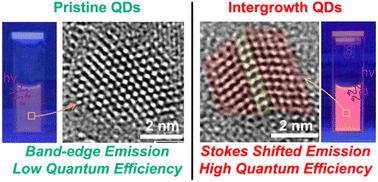Our official English website, www.x-mol.net, welcomes your
feedback! (Note: you will need to create a separate account there.)
Boosting quantum efficiency and suppressing self-absorption in CdS quantum dots through interface engineering
Nanoscale ( IF 5.8 ) Pub Date : 2024-11-07 , DOI: 10.1039/d4nr02990a Shyamashis Das, Biswajit Bhattacharyya, Ashutosh Mohanty, Poulomi Mukherjee, Arpita Mukherjee, Anirban Dutta, Anshu Pandey, Priya Mahadevan, Ranjani Viswanatha, D. D. Sarma
Nanoscale ( IF 5.8 ) Pub Date : 2024-11-07 , DOI: 10.1039/d4nr02990a Shyamashis Das, Biswajit Bhattacharyya, Ashutosh Mohanty, Poulomi Mukherjee, Arpita Mukherjee, Anirban Dutta, Anshu Pandey, Priya Mahadevan, Ranjani Viswanatha, D. D. Sarma

|
Applications of photoluminescence (PL) from semiconductor quantum dots (QDs) have faced the dichotomy of excitonic emission being susceptible to self-absorption and shallow defects reducing quantum yield (QY) catastrophically, and doped emissions sacrificing the tunability of the emission wavelength via a quantum size effect, making it extremely challenging, if not impossible, to optimize all desirable properties simultaneously. Here we report a strategy that simultaneously optimizes all desirable PL properties in CdS QDs by leveraging interface engineering through the growth of two crystallographic phases, namely wurtzite and zinc blende phases, within individual QDs. These engineered interfaces result in sub-bandgap emissions via ultrafast energy transfer (∼780 fs) from band-edge states to interface states protected from surface defects, enhancing stability and prolonging the PL lifetime. These sub-bandgap emissions involving the interface states show a high Stokes shift, significantly reducing self-absorption while achieving near-ideal quantum efficiencies (> 90%); we also achieved extensive emission tunability by controlling the QD size without sacrificing efficiency. Theoretical calculations confirm that the interface states act as planar antennas for an efficient energy transfer from the bandgap states, while the extended nature of these states imparts tunability via quantum confinement effects, underpinning remarkable optical performance. This interface-engineered approach offers a powerful strategy to overcome limitations in QD-based optoelectronic applications.
中文翻译:

通过界面工程提高量子效率并抑制 CdS 量子点中的自吸收
半导体量子点 (QD) 的光致发光 (PL) 应用面临着激子发射易受自吸收和浅缺陷灾难性地降低量子产率 (QY) 的二分法,而掺杂发射通过量子尺寸效应牺牲了发射波长的可调性,这使得同时优化所有所需特性极具挑战性,如果不是不可能的话。在这里,我们报告了一种策略,该策略通过在单个量子点内生长两个晶体学相(即纤锌矿和闪锌矿相)来利用界面工程,同时优化 CdS QD 中所有理想的 PL 特性。这些工程接口通过超快能量转移 (∼780 fs) 从带边缘状态到不受表面缺陷影响的界面状态产生亚带隙发射,从而提高稳定性并延长 PL 的使用寿命。这些涉及界面态的亚带隙发射显示出高斯托克斯位移,显著降低自吸收,同时实现接近理想的量子效率 (> 90%);我们还通过控制 QD 大小而不牺牲效率实现了广泛的发射可调性。理论计算证实,界面态充当平面天线,从带隙态进行有效的能量传输,而这些态的扩展性质通过量子限制效应赋予可调谐性,为卓越的光学性能奠定了基础。这种接口工程方法提供了一种强大的策略来克服基于 QD 的光电应用中的局限性。
更新日期:2024-11-07
中文翻译:

通过界面工程提高量子效率并抑制 CdS 量子点中的自吸收
半导体量子点 (QD) 的光致发光 (PL) 应用面临着激子发射易受自吸收和浅缺陷灾难性地降低量子产率 (QY) 的二分法,而掺杂发射通过量子尺寸效应牺牲了发射波长的可调性,这使得同时优化所有所需特性极具挑战性,如果不是不可能的话。在这里,我们报告了一种策略,该策略通过在单个量子点内生长两个晶体学相(即纤锌矿和闪锌矿相)来利用界面工程,同时优化 CdS QD 中所有理想的 PL 特性。这些工程接口通过超快能量转移 (∼780 fs) 从带边缘状态到不受表面缺陷影响的界面状态产生亚带隙发射,从而提高稳定性并延长 PL 的使用寿命。这些涉及界面态的亚带隙发射显示出高斯托克斯位移,显著降低自吸收,同时实现接近理想的量子效率 (> 90%);我们还通过控制 QD 大小而不牺牲效率实现了广泛的发射可调性。理论计算证实,界面态充当平面天线,从带隙态进行有效的能量传输,而这些态的扩展性质通过量子限制效应赋予可调谐性,为卓越的光学性能奠定了基础。这种接口工程方法提供了一种强大的策略来克服基于 QD 的光电应用中的局限性。


















































 京公网安备 11010802027423号
京公网安备 11010802027423号